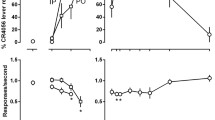Abstract
Antagonistic actions of the irreversible, μ-selective antagonist β-funaltrexamine (β-FNA) were evaluated in pigeons trained to discriminate among intramuscular injections of morphine (5.6 mg/kg), saline, and naltrexone (10.0 mg/kg). β-FNA administered alone (1.0 or 10.0 mg/kg) failed to mimic the discriminative stimulus effects of morphine or naltrexone. β-FNA attenuated the discriminative stimulus effects of morphine. A three-fold larger dose of morphine was required for complete generalization when pigeons were pretreated with a dose of 1.0 mg/kg β-FNA. A dose of 10.0 mg/kg β-FNA completely antagonized the morphine discriminative stimulus, so that pigeons responded predominantly on the saline key up to doses of morphine that suppressed responding. Doses of β-FNA that attenuated the effects of morphine had no effect on the discriminative stimulus effects of naltrexone. These results demonstrate that, like naltrexone, β-FNA attenuates the discriminative stimulus effects of morphine in pigeons and, at sufficiently large doses, antagonizes morphine in an unsurmountable manner. β-FNA does not, however, share discriminative stimulus properties with naltrexone in these pigeons, and fails to attenuate the discriminative stimulus effects of naltrexone, lending support to the suggestion that naltrexone exerts discriminative stimulus effects under these experimental conditions predominantly by a non-mu opioid mechanism.
Similar content being viewed by others
References
Bertalmio AJ, Herling S, Hampton RY, Winger G, Woods JH (1982) A procedure for the rapid evaluation of the discriminative stimulus effects of drugs. J Pharmacol Methods 7:289–299
France CP, Woods JH (1985a) Antagonistic and rate-suppressing effects of opioid antagonists in the pigeon. J Pharmacol Exp Ther 235:442–447
France CP, Woods JH (1985b) Opiate agonist-antagonist interactions: application of a three-key drug discrimination procedure. J Pharmacol Exp Ther 234:81–89
Gmerek DE, Woods JH (1985) Effects of β-funaltrexamine in normal and morphine-dependent rhesus monkeys: observational studies. J Pharmacol Exp Ther 235:296–301
Grevel J, Sadee W (1983) An opiate binding site in the rat brain is highly selective for 4,5-epoxymorphinans. Science 221:1198–1201
Herling S, Coale EH Jr, Valentino RJ, Hein DW, Woods JH (1980) Narcotic discrimination in pigeons. J Pharmacol Exp Ther 214:139–146
Portoghese PS, Larson DL, Sayre LM, Fries DS, Takemori AE (1980) A novel opioid receptor site directed alkylating agent with irreversible narcotic antagonistic and reversible agonistic activities. J Med Chem 23:233–235
Rosenbaum JS, Sadee W (1982) Demonstration of opiate receptor sub-type in vivo. Life Sci 31:1299–1301
Rosenbaum JS, Holfold NHG, Richards ML, Aman RA, Sadee W (1984) Discrimination of three types of opioid binding sites in rat brain in vivo. Mol Pharmacol 25:242–248
Takemori AE, Larson DL, Portoghese PS (1981) The irreversible narcotic antagonistic and reversible agonistic properties of the fumaramate methyl ester derivative of naltrexone. Eur J Pharmacol 70:445–451
Valentino RJ, Herling S, Woods JH (1983) Discriminative stimulus effects of naltrexone in narcotic-naive and morphine-treated pigeons. J Pharmacol Exp Ther 224:307–313
Ward SJ, Portoghese PS, Takemori AE (1982) Pharmacological characterization in vivo of the novel opioid, β-funaltrexamine. J Pharmacol Exp Ther 220:494–498
White JM, Holtzman SG (1981) Three-choice drug discrimination in the rat: Morphine, cyclazocine and saline. J Pharmacol Exp Ther 217:254–262
White JM, Holtzman SG (1983) Further characterization of the three-choice morphine, cyclazocine and saline discrimination paradigm: Opioids with agonist and antagonist properties. J Pharmacol Exp Ther 224:95–99
Woods JH, France CP, Bertalmio AJ, Gmerek DE, Winger G (1985) Behavioral assessment of insurmountable narcotic agonists and antagonists. In: Seiden LS, Balster RL (eds) Behavioral pharmacology: the current status. Alan R. Liss, New York, pp 75–92
Author information
Authors and Affiliations
Rights and permissions
About this article
Cite this article
France, C.P., Woods, J.H. β-funaltrexamine antagonizes the discriminative stimulus effects of morphine but not naltrexone in pigeons. Psychopharmacology 91, 213–216 (1987). https://doi.org/10.1007/BF00217065
Received:
Revised:
Issue Date:
DOI: https://doi.org/10.1007/BF00217065




